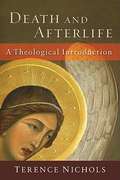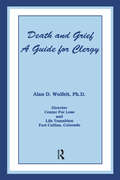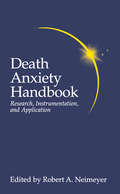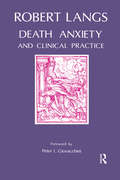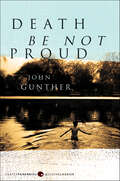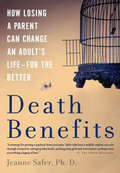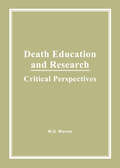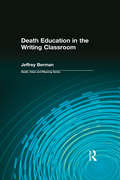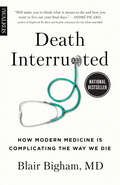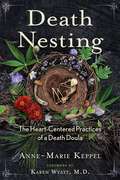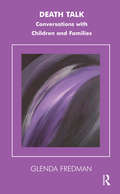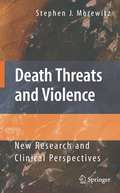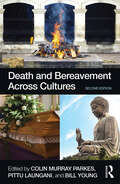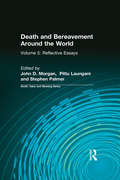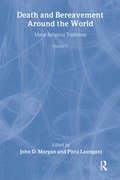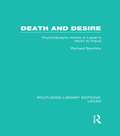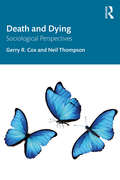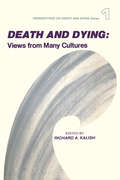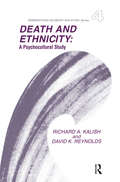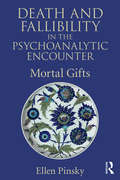- Table View
- List View
Death And Afterlife: A Theological Introduction
by Terence NicholsMany people fear dying and are uncertain about life after death. In this engaging book, a Catholic theologian addresses perennial human questions about death and what lies beyond, making a Christian case for an afterlife with God. Nichols begins by examining views of death and the afterlife in Scripture and the Christian tradition. He takes up scientific and philosophical challenges to the afterlife and considers what we can learn about it from near death experiences. Nichols then addresses topics such as the soul, bodily resurrection, salvation, heaven, hell, and purgatory. Finally, he addresses the important issue of preparing for death and dying well.
Death And Grief: A Guide For Clergy
by Alan D. WolfeltFirst Published in 1988. Routledge is an imprint of Taylor & Francis, an informa company.
Death And Trauma: The Traumatology Of Grieving (Series in Trauma and Loss)
by Charles R. Figley Nicholas Mazza Brian E. BrideFirst published in 1997. Although the fields of thanatology and traumatology have received robust attention during their parallel development, little effort has been made to address their overlapping territory. This volume is the first attempt to do so. Specifically, the purpose of this book is fourfold. First is to provide a theoretical bridge between the two fields by providing conceptual terminology, such as defining normal versus dysfunctional bereavement and the meaning and range of death-related PTSD. The second confirms and illustrates the identical patterns of reactions between those who survive the death of a loved one and those who survive other traumatic events. Next the book applies the most useful theoretical models to the bereavement experience, and in turn acknowledges the utility of generalizing bereavement models to other traumatic experiences; in doing so, the two fields can enrich each other. Similarly, the volume's final purpose is to identify and apply the most useful and effective approaches in traumatology literature to the study, diagnosis and treatment of traumatic stressors other than death.
Death Anxiety Handbook: Research, Instrumentation, And Application (Death, Education, Aging and Health Care)
by Robert A. NeimeyerPresenting a broad coverage of this major area of studies on death and dying, this book provides a systematic presentation of the six most widely used and best validated measures of death anxiety, threat and fear. These chapters consider the available data on the psychometric properties of each instrument and summarize research using them, and also supply a copy of the instrument with scoring keys - to facilitate their use. In addition, other chapters make use of the instrumentation by pursuing questions of applied significance in various health care settings nursing homes, psychotherapy, death education, near death experiences, persons with AIDS, experiences of bereaved young adults.; An introductory chapter introduces the major philosophical and psychological theories of the causes and consequences of death anxiety in adult life, and a closing chapter gives an overview of death education and how this affects attitudes towards death and dying.
Death Anxiety and Clinical Practice
by Robert LangsRobert Langs argues that death anxiety is neglected - in part, because of treatment failures due to countertransference interferences during treatment. He then discusses the technical issues connected with this, whilst introducing the controversial concept that mental activities are derived from immune system activities.
Death Attitudes and the Older Adult: Theories Concepts and Applications (Series in Death, Dying, and Bereavement)
by Adrian TomerThis innovative and informative new text bridges the fields of gerontology and thanatology.
Death Be Not Proud
by John J. Gunther"If courage is the antidote to pain and grief, the disease and the cure are both in this book. . . . A story of great unselfishness and great heroism." —New York TimesJohnny Gunther was only seventeen years old when he died of a brain tumor. During the months of his illness, everyone near him was unforgettably impressed by his level-headed courage, his wit and quiet friendliness, and, above all, his unfaltering patience through times of despair. This deeply moving book is a father's memoir of a brave, intelligent, and spirited boy.
Death Benefits: How Losing a Parent Can Change an Adult's Life -- for the Better
by Jeanne SaferWhen psychotherapist Jeanne Safer lost her mother, she was determined to turn her loss into an opportunity for insight and growth. Through her own experience, her work with patients, and in-depth interviews, Safer shows that the death of a parent can be a catalyst for change. In this updated paperback edition, Safer includes a helpful resource section, including information on hospice care, rehabilitation programs, and more. Bold, surprising, and compassionate, Death Benefits challenges the idea that loss must simply be endured or overcome.
Death Education and Research: Critical Perspectives
by William G WarrenA critical review of research and reflection in the area of death, with special emphasis on death education. Thought-provoking, often controversial reviews of and reactions to the current general domain of death phenomena--specifically death education--are addressed in this book. The author, skeptical that we can do very much with the phenomenon of death and dying, especially in relation to our efforts at addressing it educationally, explores the philosophical, psychological, socio-cultural, and theoretical aspects and raises critical questions that will challenge proponents of death education. Both advocates and critics of death education in particular, and death research in general, will benefit from this intellectually stimulating volume that sounds a cautionary note, yet offers some positive suggestions for the future of death education. Professionals interested in any aspect of death education will be intrigued by this thorough examination of death education from several perspectives.
Death Education in the Writing Classroom (Death, Value and Meaning Series)
by Jeffrey BermanDeath is often encountered in English courses—Hamlet’s death, celebrity death, death from the terrorist attacks on 9/11—but students rarely have the opportunity to write about their own experiences with death. In Death Education in the Writing Classroom, Jeffrey Berman shows how college students can write safely about dying, death, and bereavement. The book is based on an undergraduate course on love and loss that Berman taught at the University at Albany in 2008. Part 1, “Diaries,” is organized around Berman’s diary entries written immediately after each class. These entries provide a week-by-week glimpse of class discussions, highlighting his students’ writings and their developing bonds with classmates and teacher. Part 2, "Breakthroughs," focuses on several students’ important educational and psychological discoveries in their understanding of love and loss. The student writings touch on many aspects of death education, including disenfranchised grief. The book explores how students write about not only mourning and loss but also depression, cutting, and abortion—topics that occupy the ambiguous border of death-in-life. Death Education in the Writing Classroom is the first book to demonstrate how love and loss can be taught in a college writing class—and the first to describe the week-by-week changes in students’ cognitive and affective responses to death. This interdisciplinary book will be of interest to writing teachers, students, clinicians, and bereavement counselors.
Death Interrupted: How Modern Medicine Is Complicating the Way We Die
by Blair BighamIn Death Interrupted, ICU doctor Blair Bigham shares his first-hand experiences of how medicine has complicated the way we die and offers a road map for dying in the modern era. Doctors today can call on previously unimaginable technologies to help keep our bodies alive. In this new era, most organs can be kept from dying almost indefinitely by machines. But this unprecedented shift in end-of-life care has created a major crisis. In the widening grey zone between life and death, doctors fight with doctors, families feel pressured to make tough decisions about their loved ones, and lawyers are left to argue life-and-death cases in the courts. Meanwhile, intensive care patients are caught in purgatory, attached to machines and unable to speak for themselves. In Death Interrupted, Dr. Blair Bigham seeks to help readers understand the options facing them at the end of their lives. Through conversations with end-of-life professionals — including ethicists, social workers, and nurses and doctors who practise palliative care — and observations from his own time working in ambulances, emergency rooms, and the ICU, Bigham exposes the tensions inherent in this new era of dying and answers the tough questions facing us all. Because now, for the first time in human history, we may be able to choose how our own story ends.
Death Is But a Dream: Finding Hope and Meaning in End of Life Dreams
by Christopher Kerr Carine MardorossianThe first book to validate the meaningful dreams and visions that bring comfort as death nears.Christopher Kerr is a hospice doctor. All of his patients die. Yet he has cared for thousands of patients who, in the face of death, speak of love and grace. Beyond the physical realities of dying are unseen processes that are remarkably life-affirming. These include dreams that are unlike any regular dream. Described as "more real than real," these end-of-life experiences resurrect past relationships, meaningful events and themes of love and forgiveness; they restore life's meaning and mark the transition from distress to comfort and acceptance. Drawing on interviews with over 1,400 patients and more than a decade of quantified data, Dr. Kerr reveals that pre-death dreams and visions are extraordinary occurrences that humanize the dying process. He shares how his patients' stories point to death as not solely about the end of life, but as the final chapter of humanity's transcendence. Kerr's book also illuminates the benefits of these phenomena for the bereaved, who find solace in seeing their loved ones pass with a sense of calm closure. Beautifully written, with astonishing real-life characters and stories, this book is at its heart a celebration of our power to reclaim the dying process as a deeply meaningful one. Death Is But a Dream is an important contribution to our understanding of medicine's and humanity's greatest mystery.
Death Nesting: The Heart-Centered Practices of a Death Doula
by Anne-Marie KeppelA practical and compassionate guide to physically, emotionally, and spiritually caring for the dying• Shares practices for emotional soothing, breathing techniques to reduce anxiety and pain, ways to reduce stress during the active dying process, and techniques to physically care for the dying, including methods to assist bedridden individuals • Explores ceremony and energetic boundary guidelines, Reiki and ancestral support techniques, and herbal care for nourishing and healing on a spirit level • Presents self-care methods for moving with grief, ideas for &“things to do&” when there is nothing to do, mindfulness practices for contemplating your own mortality, as well as guidance for talking with children about death and dying • Winner of a 2020 Independent Publisher &“IPPY&” award Just as we might prepare a nest for one about to give birth, so can we lovingly prepare a nest for one who is dying. In this practical and compassionate guide, death doula educator Anne-Marie Keppel incorporates ancient and modern death doula techniques, mindfulness practices, and herbal support to show how anyone can physically, emotionally, and spiritually care for the dying, whether at home, in hospice, or even in the ICU. Seeking to demystify the dying process, she explains what the body physically undergoes during the end of life and shares techniques to physically care for the dying, including methods to assist bedridden individuals. She presents practices for emotional soothing, breathing techniques to reduce anxiety and pain, and ways to reduce stress during the active dying process. She shares ceremony and energetic boundary guidelines, Reiki and ancestral support techniques, and herbal care for nourishing and healing on a spirit level. Providing support for caregivers and loved ones as well, Anne-Marie explores self-care methods for moving with grief, ideas for &“things to do&” when there is nothing to do, and mindfulness practices for contemplating your own mortality. She also offers visualizations and techniques for talking with children about death and dying. Sharing glimpses into the world of spirit to reveal the poignancy of the dying process, the author shows that death is a sacred rite of passage we all experience.
Death Talk: Conversations with Children and Families (The Systemic Thinking and Practice Series)
by Glenda FredmanDeath Talk is about the healing power of conversation. It gives numerous examples of children and their families being released from the grip of sadness, isolation, and fear by talking about their own experiences of death.
Death Threats and Violence
by Stephen MorewitzThis fascinating work analyzes the meaning and impact of homicidal threats, the means by which they are communicated, and their development from infrequent private occurrence to ongoing social problem. Using data from the Stalking and Violence Project and recent events including the Virginia Tech massacre, Stephen Morewitz explores the lives of the men (and to a lesser degree, women) who make threats against their partners, strangers, social groups, and institutions.
Death and Bereavement Across Cultures: Second edition
by William Young Pittu Laungani Colin Murray ParkesAll societies have their own customs and beliefs surrounding death. In the West, traditional ways of mourning are disappearing, and although Western science has had a major impact on how people die, it has taught us little about the way to die or to grieve. Many whose work brings them into contact with the dying and the bereaved from Western and other cultures are at a loss to know how to offer appropriate and sensitive support. Death and Bereavement Across Cultures 2nd Edition is a handbook which meets the needs of doctors, nurses, social workers, hospital chaplains, counsellors and volunteers caring for patients with life-threatening illness and their families before and after bereavement. It is a practical guide explaining the religious and other differences commonly met with in multi-cultural societies when someone is dying or bereaved. In doing so readers may be surprised to find how much we can learn from other cultures about our own attitudes and assumptions about death. Written by international experts in the field the book: Describes the rituals and beliefs of major world religions; Explains their psychological and historical context; Shows how customs are changed by contact with the West; Considers the implications for the future The second edition includes new chapters that: explore how members of the health care professions perform roles formerly conducted by priests and shamans can cross the cultural gaps between different cultures and religions; consider the relevance of attitudes and assumptions about death for our understanding of religious and nationalist extremism and its consequences; discuss the Buddhist, Islamic and Christian ways of death. Death raises questions which science cannot answer. Whatever our personal beliefs we can all gain from learning how others view these ultimate problems. This book explores the richness of mourning traditions around the world with the aim of increasing the sensitivity and understanding which we all bring to the issue of death and bereavement.
Death and Bereavement Around the World: Reflective Essays: Volume 5 (Death, Value, And Meaning Ser.)
by Stephen Palmer Pittu Laungani Dale A Lund John D MorganThis final volume of ""Death and Bereavement Around the World"" reflects on some major themes: death and after-life, religion and spirituality, rites and rituals, secularist approaches, cultural variations, suicide, and other issues. The first few chapters describe progress in end-of-life care, including some new tools to evaluate hospice care (chapter 1); what children know, when they know it, and how parents can respond to questions, with some guidelines for support by schools (chapter 2); the importance of ritual (chapter 3); and, gender differences in death customs around the world (chapter 4).The transcript of a 1997 interview of John (Jack) Morgan by Pittu Laungani is presented as chapter 5. The following chapters discuss death systems and suicide (chapter 6); HIV/AIDS, including the role of cultural and economic factors in the spread of the disease (chapter 7); and grief and bereavement in the developing world, taking the AIDS pandemic as a specific challenge (chapter 8). Chapter 9 covers issues related to dying and death in Romania. In chapter 10 the focus is on the various functions and uses of names in a cross-cultural context. Roadside memorials as a pivotal healing strategy are the topic of chapter 11. Chapters 12 and 13 focus on spiritual experience with loss.The final chapter presents some conclusions, and in the Epilogue, Mary Ann Morgan honors the life, career, dying, death, and achievements of John (Jack) Morgan. The 'Final Word' includes the words of Pittu Laungani, from a book published just weeks before his death in February 2007.This work is for anyone interested in or working in death and bereavement issues, particularly academics, educators, librarians, chaplains, clergy, funeral service directors, hospice care providers and volunteers, palliative care providers, nurses, immigration officers, psychologists, social workers, psychotherapists, and counselors, especially bereavement counselors.
Death and Bereavement around the World: Major Religious Traditions: Volume 1
by John D. Morgan Pittu LaunganiThe make-up of the contemporary nation-state is increasingly multiethnic and statistics show that in many cases no one group is numerically the largest. Interethnic relations are given global visibility by the media while much that happens among different groups depends on context. Editors John D. Morgan (King's College, London) and Pittu Laungani (South Bank and Manchester Universities, England) have gathered leading international authorities to produce Death and Bereavement Around the World the first of a five-volume presentation and analysis of the ways different peoples experience dying and grief. Effective bereavement care requires a knowledge of an individual's physical, social, educational, and spiritual existence since the expressions of grief and the needs that emerge vary widely from one to another and are subject to past experiences, cultural expectations, personal beliefs, and relationships. An individual's identity comes from a sense of personal uniqueness; solidarity with group ideals; continuity with the past, present and future; and from the culture by which an individual is raised or adopted. This first volume discusses the major religious traditions of the world and how they help followers deal with the fundamentals of life.
Death and Chronic Illness in the Family: Bowen Family Systems Theory Perspectives
by Peter Titelman Sydney K. ReedWhat does it mean to be ‘present and accounted for’ when a family member is facing chronic illness or death? How does one define a self in relation to the ill or dying member and the family? Rooted in Murray Bowen’s family systems theory, this edited volume provides conceptual ideas and applications useful to clinicians who work with families facing chronic illness or the death of a member. The text is divided into four parts: Part I provides a detailed overview of Bowen’s theory perspectives on chronic illness and death and includes Murray Bowen’s seminal essay "Family Reaction to Death." In Parts II and III, chapter authors draw upon Bowen theory to intimately explore their families' reactions to and experiences with death and chronic illness. The final part uses case studies from contributors’ clinical practices to aid therapists in using Bowen systems perspectives in their work with clients. The chapters in this volume provide a rich and broad range of clinical application and personal experience by professionals who have substantial knowledge of and training in Bowen theory. Death and Chronic Illness in the Family is an essential resource for those interested in understanding the impact of death and loss in their professional work and in their personal lives.
Death and Desire: Psychoanalytic Theory in Lacan's Return to Freud (Routledge Library Editions: Lacan)
by Richard BoothbyThe immensely influential work of Jacques Lacan challenges readers both for the difficulty of its style and for the wide range of intellectual references that frame its innovations. Lacan’s work is challenging too, for the way it recentres psychoanalysis on one of the most controversial points of Freud’s theory – the concept of a self-destructive drive or ‘death instinct’. Originally published in 1991, Death and Desire presents in Lacanian terms a new integration of psychoanalytic theory in which the battery of key Freudian concepts – from the dynamics of the Oedipus complex to the topography of ego, id, and superego – are seen to intersect in Freud’s most far-reaching and speculative formulation of a drive toward death. Boothby argues that Lacan repositioned the theme of death in psychoanalysis in relation to Freud’s main concern – the nature and fate of desire. In doing so, Lacan rediscovered Freud’s essential insights in a manner so nuanced and penetrating that prevailing assessments of the death instinct may well have to be re-examined. Although the death instinct is usually regarded as the most obscure concept in Freud’s metapsychology, and Lacan to be the most perplexing psychoanalytic theorist, Richard Boothby’s straightforward style makes both accessible. He illustrates the coherence of Lacanian thought and shows how Lacan’s work comprises a ‘return to Freud’ along new and different angles of approach. Written with an eye to the conceptual structure of psychoanalytic theory, Death and Desire will appeal to psychoanalysts and philosophers alike.
Death and Dying, Life and Living
by Kenneth J. Doka Charles A. Corr Donna M. CorrPractical and inspiring, this best-selling book helps students learn to cope with encounters with death, dying, and bereavement. The authors integrate classical and contemporary material, present task-based approaches for individual and family coping, and include four substantial chapters devoted to death-related issues faced by children, adolescents, adults, and the elderly. In addition, the text discusses a variety of cultural and religious perspectives that impact individuals' understandings and practices associated with such encounters. The book also offers practical guidelines for constructive communication designed to encourage productive living in the face of death.
Death and Dying: Sociological Perspectives
by Neil Thompson Gerry R. CoxDeath and Dying is an important core text for students and professionals interested in developing a holistic understanding of death and dying. Chapters are replete with case studies, activities, key point boxes, and other features that enable readers to develop a sociologically informed understanding of the broad range of complex issues that underpin death and dying. Written by two established and highly respected experts in the field, it offers a thoroughgoing account of a wide range of social aspects of death and dying, filling gaps left by the traditionally narrow focus of the existing literature. By drawing the suggested sociological perspectives and highlighting the role of social policy, the authors put forward a fresh perspective of the field of thanatology. This book is a major contribution in progressing knowledge and understanding of dying and death for students and professionals in counseling, health and human services.
Death and Dying: Views from Many Cultures (Perspectives On Death And Dying Ser. #Vol. 5)
by Richard KalishDeath is a constant in every society, but each of the world's cultures views the end of life differently. This book examines beliefs about dying, burial, and life after death held by peoples of wide ranging societies.
Death and Ethnicity: A Psychocultural Study
by Richard A KalishThe intent of Death and Ethnicity emphasizes that death occurs to us as unique individuals living within particular sociocultural settings. Those who provide and plan services need to recognize both the differences among groups and the differences among individuals within these groups; and to provide options for those representative of their group as well as for those whose wants and needs are atypical. This book is valuable for those who plan projects, programs, courses, and services concerned with death and bereavement, and those who fund, plan, direct, and perform those services.
Death and Fallibility in the Psychoanalytic Encounter: Mortal Gifts
by Ellen PinskyDeath and Fallibility in the Psychoanalytic Encounter considers psychoanalysis from a fresh perspective: the therapist’s mortality—in at least two senses of the word. That the therapist can die, and is also fallible, can be seen as necessary or even defining components of the therapeutic process. At every moment, the analyst's vulnerability and human limitations underlie the work, something rarely openly acknowledged. Freud’s central insights continue to guide the range of all talking therapies, but they do so somewhat in the manner of a smudged ancestral map. That blur, or degree of confusion, invites new ways of reading. Ellen Pinsky reexamines fundamental principles underlying by-now-dusty terms such as "neutrality," "abstinence," "working through," and the peculiar expression "termination." Pinsky reconsiders—in some measure, hopes to restore—the most essential, humane, and useful components of the original psychoanalytic perspective, guided by the most productive threads in the discipline's still-evolving theory. Freud's most important contribution was arguably to discover (or invent) the psychoanalytic situation itself. This book reflects on central questions pertaining to that extraordinary discovery: What is the psychoanalytic situation? How does it work (and fail to work)? Why does it work?? This book aims to articulate what is fundamental and what we can't do without—the psychoanalytic essence—while neither idealizing Freud nor devaluing his achievement. Historically, Freud has been misread, distorted, maligned or, at times, even dismissed. Pinsky reappraises his significance with respect to psychoanalytic writers who have extended, and amended, his thinking. Of particular interest are those psychoanalytic thinkers who, like Freud, are not only original thinkers but also great writers—including D. W. Winnicott and Hans Loewald.? Covering a broad range of psychoanalytic paradigms, Death and Fallibility in the Psychoanalytic Encounter will bring a fresh understanding of the nature, benefits and pitfalls of psychoanalysis. It will appeal to psychoanalysts and psychoanalytic psychotherapists and provide superb background and inspiration for anyone working across the entire range of talking therapies.
